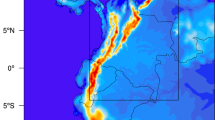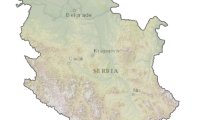Abstract
This study aims at exploring potential impacts of land-use vegetation change (LUC) on regional climate variability and extremes. Results from a pair of Australian Bureau of Meteorology Research Centre (BMRC) climate model 54-yr (1949–2002) integrations have been analysed. In the model experiments, two vegetation datasets are used, with one representing current vegetation coverage in China and the other approximating its potential coverage without human intervention. The model results show potential impacts of LUC on climate variability and extremes. There are statistically significant changes of surface interannual climate variability simulated by the model. Using different vegetation datasets, significant changes in correlation coefficients between tropical Pacific Niño3.4 SST and precipitation and surface temperature over East Asia are identified, which indicate that changes in vegetation coverage may alter ENSO impacts on regional climate variability. Because of the lack of slowly varying surface processes when forests are removed and less rainfall is received following LUC, the ENSO signal simulated by the model becomes stronger. Results furthermore show that land-use could modulate characteristics of decadal variations in this region. When using current vegetation coverage, the model gives better simulation of observed climate variations in the region than the case using potential vegetation coverage. In addition, results suggest that land-use could be a potential factor contributing to the prolonged drought in central-west China. Changes in local climate extremes, including precipitation and surface temperature maxima and minima, are also identified. Overall, this study has illustrated the importance of further investigation of such important issues in future land-use studies.
Similar content being viewed by others
References
Blalock, H., 1972: Social Statistics. McGraw Hill, New York, 640pp.
Cox, P. M., R. A. Betts, C. D. Jones, S. A. Spall, and I. J. Totterdell, 2000: Acceleration of global warming due to carbon-cycle feedbacks in a coupled climate model. Nature, 408, 184–187.
Desborough, C. E., 1999: Surface energy balance complexity in GCM land surface models. Climate Dyn., 15, 389–403.
Dickinson, R. R., 1984: Eurasian snow cover versus Indian monsoon rainfall—An extension of Hahn-Shukla results. J. Climate Appl. Meteor., 23, 171–173.
Edwards, J. M., and A. Slingo, 1996: Studies with a flexible new radiation code. I: Choosing a configuration for a large scale model. Quart. J. Roy. Meteor. Soc., 122, 689–719.
Fu, C. B., H. Harasawa, V. Kasyanov, J.-W. Kim, D. Ojima, Z. Wan, and S. Zhao, 2002: Regional-global interactions in East Asia. Global-Regional Linkage in the Earth System, Tyson et al., Eds., Springer, Berlin, 109–149.
Goswami, B. N., 1998: Interannual variations of Indian summer monsoon in a GCM: External conditions versus internal feedbacks. J. Climate, 11, 501–522.
Henderson-Sellers, A., T. B. Durbidge, A. J. Pitman, R. E. Dickinson, P. J. Kennedy, and K. McGuffie, 1993: Tropical deforestation: Modelling local to regionalscale climate change. J. Geophys. Res., 98, 7289–7315.
Houghton, J. T., Y. Ding, D. J. Griggs, M. Noguer, P. J. van der Linden, X. Dai, K. Maskell, and C. A. Johnson, Eds., 2001: Climate Change 2001: The Scientific Basis. Cambridge University Press, 892pp.
Hu, Q., and S. Feng, 2004: A role of the soil enthalpy in land memory. J. Climate, 17, 3633–3643.
IPCC, 2007, Climate Change 2007: The Physical Science Basis, Contribution of Working Group I to the Fourth Assessment Report of the Intergovernmental Panel on Climate Change. Solomon et al., Eds., Cambridge University Press, Cambridge, United Kingdom and New York, NY, USA, 996pp.
Koster, R. D., and Coauthors, 2006: GLACE: The Global Land-Atmosphere Coupling Experiment. Part I: Overview, J. Hydrometeor., 7, 590–610.
Liu, H., and G. X. Wu, 1997: Impacts of land surface on climate of July and onset of Summer monsoon: A study with an AGCM plus SSiB. Adv. Atmos. Sci., 14(3), 273–282.
Lau, K.-M., and H. T. Wu, 2001: Principal modes of rainfall-SST variability of the Asian summer monsoon: A reassessment of monsoon-ENSO relationships. J. Climate, 14, 2880–2895.
Manabe, S., 1969: Climate and the ocean circulation: 1, The atmospheric circulation and the hydrology of the Earth’s surface. Mon. Wea. Rev., 97, 739–805.
McAvaney, B. J., and G. D. Hess, 1996: The revised surface fluxes parameterisation in BMRC: Formulation. BMRC Res. Rept. 56, 27pp.
Meehl, G. A, 1994: Coupled land-ocean-atmosphere processes and the biennial mechanism in the south Asian monsoon region. Proc. Int. Conf. on Monsoon Variability and Prediction, Trieste, Italy, WMO, 637–644.
New, M., M. Hulme, and P. Jones, 1998: Representing twentieth-century space-time climate variability. Part II: Development of 1901–96 monthly grids of terrestrial surface climate. J. Climate, 13, 2217–2238.
Pitman, A. J., and B. J. McAvaney, 2002: The role of surface energy balance complexity in land surface models’ sensitivity to increasing carbon dioxide. Climate Dyn., 19, 609–618.
Power, S., F. Tseitkin, S. Torok, B. Lavery, R. Dahni, and B. McAvaney, 1998: Australian temperature, Australian rainfall and the Southern Oscillation, 1910–1992: Coherent variability and recent changes. Australian Meteor. Mag., 47, 85–101.
von Storch, H., and F.W. Zwiers, 2001: Statistical Analysis in Climate Research. Cambridge University Press, 484pp.
Shi, Z. G., X. D. Yan, C. H. Yin, and Z. M. Wang, 2007: Effects of historical land cover changes on climate. Chinese Science Bulletin, 52(18), 2575–2583.
Su, M. F., and H. J. Wang, 2006: Relationship between China wetness variability and ENSO and its stability. Science in China (D), 36(10), 951–958.
Sun, L., and G. X. Wu, 2001: Influence of land evapotranspiration on climate. Science in China(D), 44(9), 838–846.
Taylor, C, M., E. F. Lambni, N. Stephenne, R. J. Harding, and R. L. H. Essery, 2002: The influence of land use change on climate in the Sahel. J. Climate, 15, 3615–3629.
Tiedtke, M., 1989: A comprehensive mass flux scheme for cumulus parameterization in large-scale models. Mon. Wea. Rev., 117, 1779–1800.
Wang, B., R. Wu, and T. Li, 2003: Atmosphere-warm ocean interaction and its impacts on Asian-Australian monsoon variation. J. Climate, 13, 1517–1536.
Wang, G. L., and E. A. B. Eltahir, 2000: Ecosystem dynamics and the Sahel drought. Geophys. Res. Lett., 27, 795–798.
Wang, H. J., 1999: Role of vegetation and soil in the Holocene megathermal climate over China. J. Geophys. Res., 104(D8), 9361–9367.
Webster, P. J., and S. Yang, 1992: Monsoon and ENSO: Selectively interactive systems. Quart. J. Roy. Meteor. Soc., 118, 877–926.
Webster, P. J., V. O. Magana, T. N. Palmer, J. Shukla, R. A. Tomas, M. Yanai, and T. Yasunari, 1998: Monsoons: Process, predictability, and the prospects for prediction. J. Geophys. Res., 103, 14451–14510.
Wu, R., and B. Wang, 2002: A contrast of the east Asian summer monsoon-ENSO relationship between 1962–77 and 1978-93. J. Climate, 15, 3266–3279.
Wu, R., Z.-Z. Hu, and B. Kirtman, 2003: Evolution of ENSO-related rainfall anomalies in East Asia. J. Climate, 16, 3742–3758.
Xu, X. K., F. Zhang, and J. K. Levy, 2007: The influence of land surface changes on regional climate in Northwest China. Adv. Atmos. Sci., 24, 527–537, doi: 10.1007/s00376-007-0527-6.
Yang, F., and K.-M. Lau, 2004: Trend and variability of China precipitation in Spring and Summer: Linkage to sea-surface temperatures. International Journal of Climatology, 24, 1625–1644.
Zeng, N., J. D. Neelin, K. M. Lau, and C. J. Tucker, 1999: Enhancement of interdecadal climate variability in the Sahel by vegetation interaction. Science, 286, 1537–1540.
Zhai, P., X. Zhang, H. Wan, and X. Pan, 2005: Trends in total precipitation and frequency of daily precipitation extremes over China. J. Climate, 18, 1096–1108.
Zhang, H., A. Henderson-Sellers, and K. McGuffie, 1996: Impacts of tropical deforestation I: Process analysis of local climatic change. J. Climate, 9, 1497–1517.
Zhang, H., A. Henderson-Sellers, and K. McGuffie, 2001: The compounding effects of tropical deforestation and greenhouse warming on climate. Climatic Change, 49, 309–338.
Zhang, H., 2004: Analyzing the potential impacts of soil moisture on the observed and model-simulated Australian surface temperature variations. J. Climate, 17, 4190–4212.
Zhang, H., X. Gao, and Y. Li, 2008: Exploring uncertainties in climate model simulations of the impacts of land-cover change on Asian monsoon climate. Oral presentation at the EGU General Assembly, Vienna, Austria, 13–18 April 2008. Geophysical Research Abstracts, Vol. 10, EGU2008-A-00952, 2008 SRef-ID: 1607-7962/gra/EGU2008-A-00952.
Zhang, H., and X. Gao, 2009: On the atmospheric dynamical responses to land-use change in East Asian monsoon region. Climate Dyn., 31, 409–426, doi:10.1007/s00382-008-0472-9.
Zhang, H., X. Gao, and Y. Li, 2009: Climate impacts of land-use in China and its uncertainty in a global model simulation. Climate Dyn., 32, 473–494.
Zhang, X., 1993: The vegetation-climate classification system for global change study. Quaternary Research, 2, 157–169.
Author information
Authors and Affiliations
Corresponding author
Rights and permissions
About this article
Cite this article
Zhang, H., Li, Y. & Gao, X. Potential impacts of land-use on climate variability and extremes. Adv. Atmos. Sci. 26, 840–854 (2009). https://doi.org/10.1007/s00376-009-8047-1
Received:
Revised:
Published:
Issue Date:
DOI: https://doi.org/10.1007/s00376-009-8047-1




